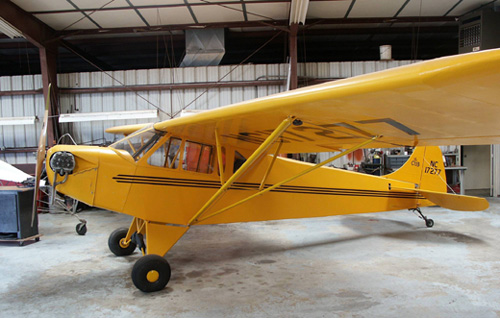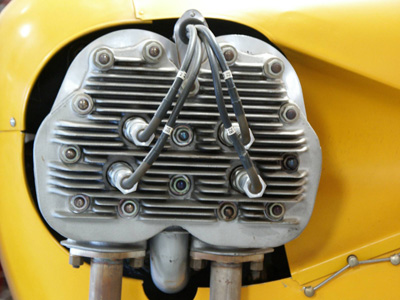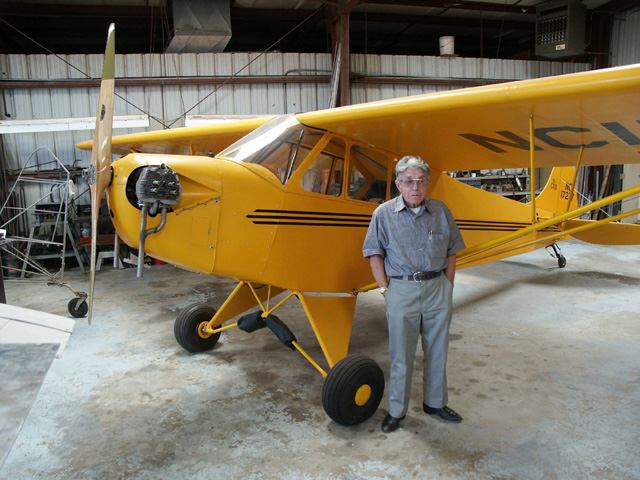
|
 |
The Venerable Taylor J-2 Cub by Randy Minnick |
 |
 |
 |
 |
 |
|---|---|---|---|---|---|---|---|
 |
 |
 |
 |
 |
|||
 |
||
|
To say she is a "beut" is a sizeable understatement. DelAir business owner Harry Dellicker advised that no expense was spared by the owner who wanted a "new" Taylor J-2. Given the outcome of Harry's masterful touch—the man surely got his money's worth. This airplane is pristine. C. G. Taylor would have been greatly pleased to see this one-of-a-kind trophy. |
| For those unfamiliar with the (original) "Cub", the Taylor J-2 was the improvement over the earlier E-2 with the "J" standing for Walter Jamouneau (a Taylor aeronautical engineer). Early models were a red color with silver trim until the new "Cub Yellow" was assigned. It is an interesting side note that C. G. Taylor was not impressed with Jamouneau's work and fired him. Later, William T. Piper rehired him and the rest, as they say, is history. The little 525 lb (238 kg) (empty) plane is powered by the same 37-40 hp (28-30 kW) Continental engine as the E-2. Noteworthy is that the 144 lb (65 kg) 115 CID air-cooled A40 is considered to be the simplest four-stroke aircraft engine ever built. |
 |
Dellicker tendered even more information about this exact aircraft (serial #934). It had been built in 1935 but didn't receive certification until 1936 and is licensed accordingly. Another interesting tidbit is that, though the owner has more than one Continental A40 engine, he elected to have the A40-5 engine installed since it has the (optional) dual ignition. It is unlikely that any pilot would take exception that decision. |
| It may seem to be a bit of a shocker for some to note that both an airspeed indicator and a compass were options for the J-2. Now that's "seat of the pants" flying! For safety's sake, the Cub at "DelAir" now has a simple-but-effective airspeed indicator (originally intended for ultra-light aircraft) mounted on the starboard wing strut. |  |
 |
Those who have flown J-2s (solo only from the rear seat which remained with the J-3s) recount they certainly enjoy the freedom of basic flight. Even some professional pilots advise that it's the most enjoyable flying they have experienced. But, they find it somewhat amazing to often have highway traffic passing them. Climb capability was also weak (even when flown solo) which attests to the craft being rather underpowered. |
|
This was acceptable back then given the fact that man had been undertaking powered flight for only a little more than 30 years. And, the nation was in the middle of a soul-rending depression which slowed technologic advancement somewhat. That meant that there simply weren't any other reliable and practical small light-weight engines available at the time. Those came about in the mid-1930s largely as a result of the new high-octane gasoline which allowed higher compression without fuel detonation. The higher compression then allowed for more horsepower in a given engine displacement rather than merely increasing displacement to obtain more horsepower. That meant that you could obtain more horsepower from a smaller lighter engine. They were just in time for use on a small, inexpensive, two-place airplane.
|
 |
| It isn't known how long NC17277 will remain at KPTV. What is assured is that there is one pleased owner of a gorgeous Taylor J-2 Cub. |
| Specifications: | |
|---|---|
| Taylor J-2 NC17277 | |
| Dimensions: | |
| Wing span: | 35 ft 3 in (10.74 m) |
| Length: | 22 ft 3 in (6.78 m) |
| Height: | 6 ft 6 in (1.98 m) |
| Weights: | |
| Empty: | 525 lb (238 kg) |
| Max Gross: | 925 lb (419 kg) |
| Performance: | |
| Maximum Speed: | 78 mph (125 km/h) |
| Cruise Speed: | 65 mph (104 km/h) |
| Climb: | 450 ft/min (137 m/min) |
| Service Ceiling: | 12,000 ft (3,657 m) |
| Range: | 220 miles (354 km) |
| Powerplant: | |
| Continental A-40-5, 40 hp (30 kw) 4-cylinder, opposed, air cooled. | |
Locations and dispositions of some J-2's:
|
Old Rheinbeck Aerodrome, NY (presently on loan to the Niagara Aerospace Museum) - serial # and reg. unknown
College Park Aviation Museum, College Park Maryland - serial #771 (NC16769) Bellevue, OH (Piper) - serial #1685 (NC19285) New Plymouth, New Zealand - (reg. and serial #unknown) Wilshire, England (Old Sarum Airport) - serial # unk (G-JTWO - formerly NC19554) The first Piper J-2 is in the Smithsonian Museum (NC20137) - serial #1937 according to one source Sonoma, CA - serial #927 (NC17261) Minden, NV (Piper) - serial #1718 (NC19518) Iowa Aviation Museum - Greenfield, IA (Greenfield Municipal) - serial #913 (NC17247) Victoria, Australia - serial # 959 (VH-UYM) At least one Taylor J-2 was to have been used by the Fuerza Aerea de la Guardia Nacional de Nicaragua but crashed on the delivery/ferry flight in 1937 |
The author Randy Minnick is a freelance writer who resides in Porterville, CA. randyminnick@charter.net
©Randy Minnick . The Aviation History Online Museum.
All rights reserved.
Created July 30, 2007. Updated November 28, 2013.